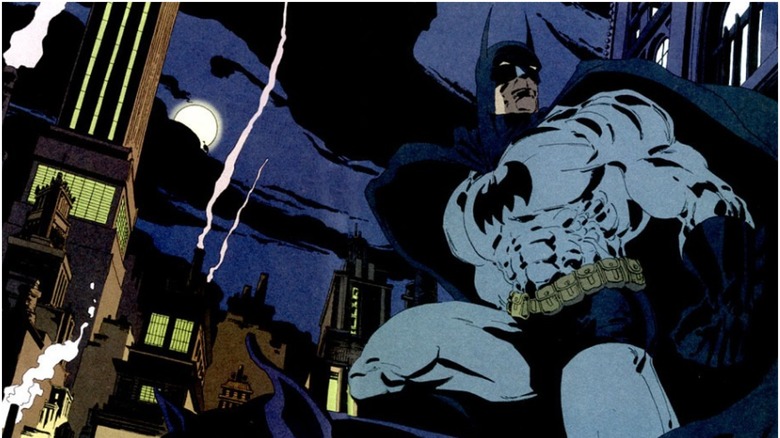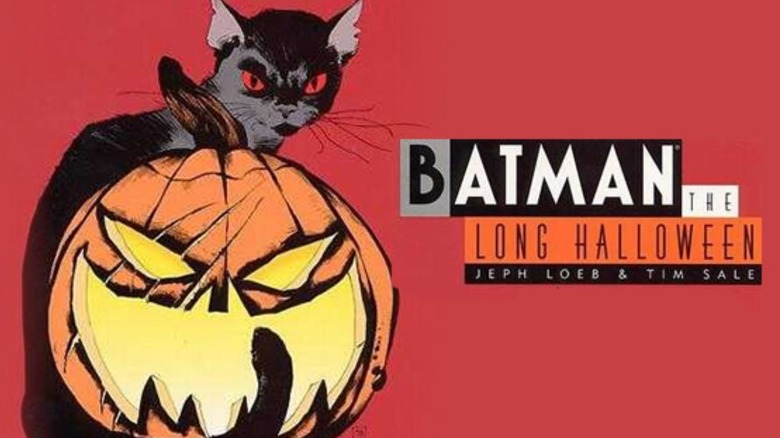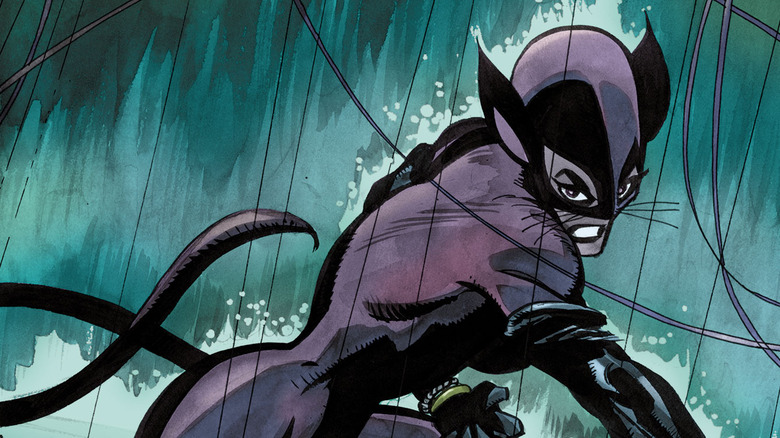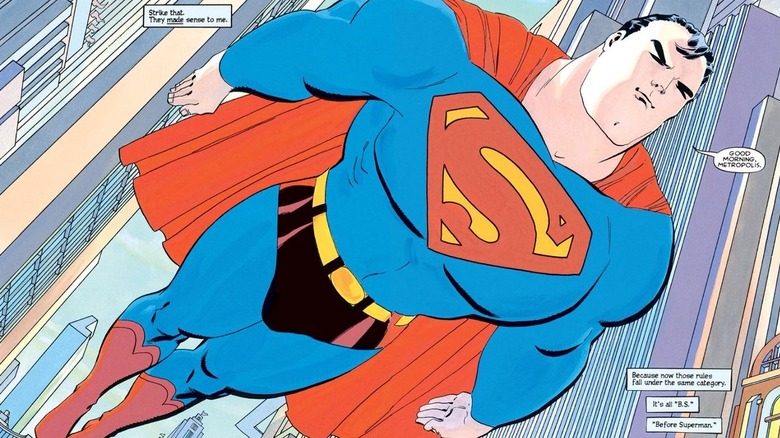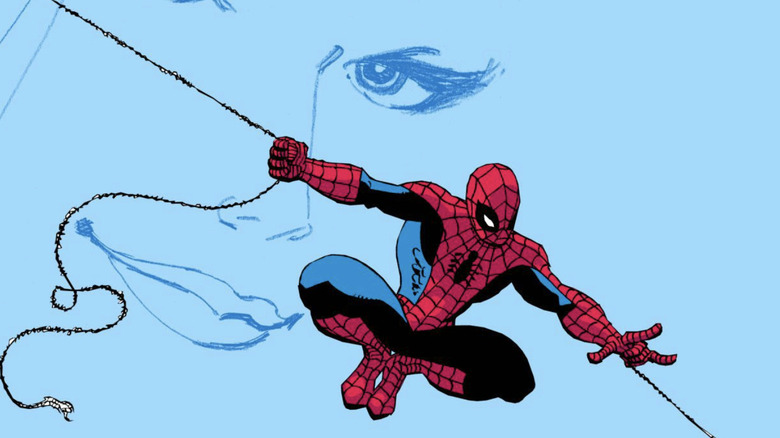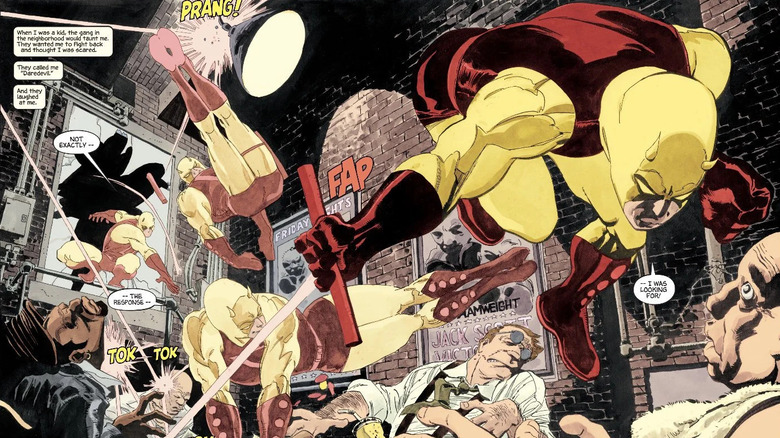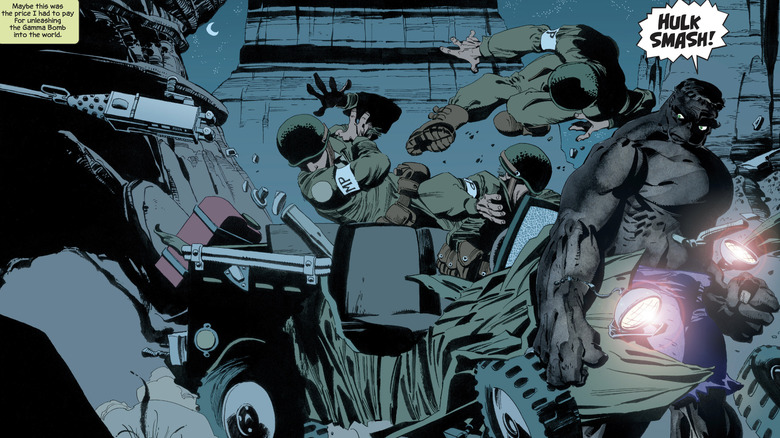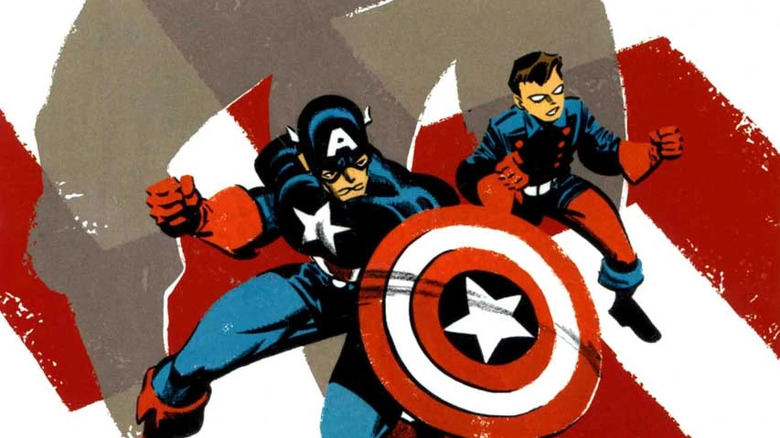7 Great Tim Sale Comics Movie Fans Need To Read
Only halfway through 2022 and we've already lost multiple comic book legends. April 28 saw the passing of Neal Adams, while little more than a week later on May 6, George Pérez succumbed to a battle with pancreatic cancer. About a month later, Tim Sale passed on June 16 at the too-young age of 66.
Renowned for his distinctive, painterly, and watercolor art style, Sale's work could be bright and inspiring, or gothic and gloomy, but no matter the mood, it was always beautiful. A frequent collaborator of writer Jeph Loeb, the pair brought to life more than their fair share of classic superhero comics at both DC and Marvel. If there are superhero movie fans out there looking to read some of the comic source material, Sale's work is a great place to start.
Batman: The Long Halloween
From 1993 to 1995, Loeb and Sale collaborated on three Batman one-shots: "Fears," "Madness," and "Ghosts." These three, collectively known as "Haunted Knight," became a beta run for their 13-issue miniseries, "Batman: The Long Halloween," which has become one of the most influential Batman stories since its 1996-1997 publication.
Sale's art in this book is definitely some of his darkest; there's consistent use of shadow, complementing the noir mood. Sale's drawings of Batman himself is one of the most distinctive Dark Knight designs; long ears, a blue cowl so cool its color fades into the gray body-suit, and a flowing cape that often looks like it's engulfing the Caped Crusader. Typically comic "splash pages" are overstuffed, with multiple heroes/villains slamming into each other like when a child plays with action figures. Sale, though, often focuses on just one subject, whether it be Batman perched atop a skyscraper or the Scarecrow riding horseback. This results in cleaner, more memorable images.
Now as for the story: Set in the second year of Batman's career, an alliance between Batman, Harvey Dent, and James Gordon to bring down the Gotham mob is complicated by a serial killer, "Holiday." Each of the 13 issues is set on a particular holiday when the killer claims a new victim.
"The Long Halloween" was one of the main story inspirations for Christopher Nolan's "The Dark Knight." The comic and film share many story beats, from the Batman/Dent/Gordon triumvirate, to Dent's tragic transformation into Two-Face, to the Gotham mob being eclipsed by super-villains. The serial killer mystery and the exploration of how the death of Bruce Wayne's parents weighs on him also influenced Matt Reeves' recent "The Batman."
Catwoman: When in Rome
Speaking of "The Batman," an important part of that film is the burgeoning romance between Batman (Robert Pattinson) and Selina Kyle (Zoë Kravitz). Reeves' Catwoman owes a lot to Loeb and Sale's, particularly her being the illegitimate daughter of Gotham kingpin, Carmine "The Roman" Falcone. In fact, that connection is what the pair's spin-off miniseries, "Catwoman: When in Rome," centers on. After learning that Falcone maybe her father, Selina flies to Rome (with Eddie Nygma/The Riddler in tow) to investigate her roots. Along the way, she gets entangled with another cat-woman; Barbara Minvera, aka the Cheetah.
"When in Rome" is breezier than "The Long Halloween," thanks to its shorter length (only six issues) and its protagonist. Whereas Batman's a stick in the mud, Selina never passes up the chance to have some fun. Sale's art complements the tone with a more varied color palette; the shadows aren't totally gone, but it's easier for Selina to escape them now that she's left Gotham.
Sale clearly enjoyed drawing Selina out of her Catwoman costume as much as he did her in it. He mimicked the style of French fashion illustrator René Gruau for the fabulous Selina wears on the book's covers.
Superman: For All Seasons
It wasn't just Gotham City where Sale left his mark on the DC Universe. "Superman: For All Seasons" is the Man of Steel's answer to "The Long Halloween." Instead of holidays, each chapter is built around one of the four seasons we experience here on Superman's adopted homeworld. The series begins before Clark becomes Superman, back when he's still a teenager dating Lana Lang in Smallville. Sale's renditions of Smallville as a quiet, rural patch of Americana are right out of a Norman Rockwell painting; both artists bring a touch of realism to pure fantasy.
It wouldn't be a superhero book without action though. For every two spread of Clark and his father peacefully watching the sunset, there's another of Superman punching an out-of-control missile. The story of "For All Seasons" is similar to John Byrne's 1986 rebooted origin story, "The Man of Steel," but while that story felt overcome by '80s cynicism, Loeb and Sale embrace the spirit of the Richard Donner/Christopher Reeve "Superman" movie. "For All Seasons" is a portrait of an America that, like Superman himself, never quite existed outside of dreams.
Spider-Man: Blue
Now onto Sale's Marvel work. Together, he and Loeb crafted a "Color" tetralogy of Marvel superheroes looking back on the past and remembering times shared with a late loved one. The best of these is "Spider-Man: Blue," where Peter Parker remembers Gwen Stacy on a Valentine's Day many years after her last one. Peter says that because of Gwen, he always feels a melancholic blue on the holiday.
"Spider-Man: Blue" broadly recreates "Amazing Spider-Man #40 – 49," the period where Peter and Gwen first started dating, while Peter's eventual wife Mary Jane Watson entered both their lives (per Peter: "You can't really tell the story of how Gwen Stacy and I fell in love without talking about Mary Jane Watson"). This was also around the period when John Romita took over artist duties on "Amazing Spider-Man" from co-creator Steve Ditko. Sale mimics Romita, giving Peter and the male characters the squared jaw, "toothpaste smile" look Romita was famous for while Gwen and MJ are Ann Margret-inspired bombshells; Sale's rendition of the "Face it, Tiger, you just hit the jackpot!" closing of "Amazing Spider-Man #42" rivals Romita's original.
"Spider-Man: Blue" has a brighter, more varied palette than any of Sale's DC work; despite the title, it's the reds, from Spidey's costume to MJ's hair, that pop the most. This brightness reflects how the extended flashbacks are Peter looking back with nostalgia. The present-day scenes are coated entirely in blue, save specific items like a red rose Peter leaves for Gwen where she died or a photo reel of Peter and Gwen together.
The relationship drama and Peter being in college make "Spider-Man: Blue" feel quite apiece to the Sam Raimi "Spider-Man: Trilogy." Like Loeb and Sale do here, those films are often character melodramas first, superhero stories second.
Daredevil: Yellow
If you know Daredevil through the Netflix series, you probably think of Matt Murdock as one of Marvel's darkest heroes. That's because that series is inspired by later, noir-influenced "Daredevil" runs written by Frank Miller and Brian Michael Bendis. The character's early years are a different, more comic book-y story.
"Daredevil: Yellow" focuses on these early years, specifically the first four issues when Daredevil wore a black and yellow costume, rather than his later, more famous red one. "Yellow" has the same trio of Matt, Foggy Nelson, and Karen Page (plus a love triangle between the three) but instead of the Kingpin and the Hand, DD's fighting villains like the Owl and the Purple Man.
Sale's art is some of his most dynamic, with many of the splash pages showing off Daredevil's acrobatic skill. The color palette of the book evolves, beginning darker and more blue in the early chapters before yellow takes hold and becomes the dominant color by Issue #6. Like "Spider-Man: Blue," the present and past have different color schemes; in "Yellow," the present-day scenes are entirely gray except for Daredevil's red suit.
Hulk: Gray
In his first appearance, the Hulk's skin wasn't green, but gray. The third chapter of the "Color" series, which focuses on Bruce Banner and his alter ego, is thus "Hulk: Gray." The Hulk is a character who hasn't gotten the best due on film; the lack of solo films has led to his supporting cast being neglected in the MCU. Two of those characters, his first and late love Betty Ross and super-powered psychiatrist Leonard Sampson, are pivotal in this miniseries.
In a session with Sampson (colored entirely in black-and-white, in a way that makes the sharpness of Sale's penciling stand out), Bruce looks back on how he became the Hulk. "Gray" has a darker palette than the previous two stories. Most of the story is set at night, in a nod to how the original explanation for the Hulk's transformation was sunset, werewolf style. Many scenes add rain, just to further the gloomy mood.
During a guest appearance by Iron Man in Chapter 4, the gold plating of his armor pops against the blue backgrounds and Hulk's own skin. Speaking of the Hulk, Sale draws the character like Frankenstein's monster as played by Boris Karloff, square head and all. The parallels between these characters couldn't be more obvious.
"Hulk: Gray" is also the most tragic of the stories. While "Blue" and "Yellow" end with Peter and Matt sad but accepting of their losses, in "Gray," the Hulk runs away from Sampson. Alone on a cliffside, he forlornly looks at a picture of Betty as tears stream down his green cheeks.
Captain America: White
Loeb and Sale's last full-length collaboration was "Captain America: White." It took a stint in development hell; after issue #1 was published in 2008, there was radio silence for seven years before the rest arrived in 2015.
Fans of the MCU probably know that Steve Rogers' best friend Bucky Barnes was thought dead but turned out to be alive. This is thanks to Ed Brubaker's 2005 "Winter Soldier" comic storyline (the inspiration for the second "Captain America" film). Before that, Cap spent four decades thinking his sidekick was truly gone. "Captain America: White" takes place during those years; the flashbacks follow Cap and Bucky's adventures during World War II. If you feel like "Captain America: The First Avenger" shortchanged Steve and Bucky's friendship and you want more, this is the book for you.
The comic follows them across different fronts, from Omaha Beach to a tank-beset No Man's Land to a wintery forest. This all culminates in Nazi-occupied Paris, where the pair have to stop the Red Skull from looting the Louvre. Across these different locales, Sale consistently uses colors of black and orange, reflecting the hell that is war.
Just as Cap and Bucky preserved the art of the Louvre for future generations to enjoy, Sale leaves behind an artistic legacy that will endure.
